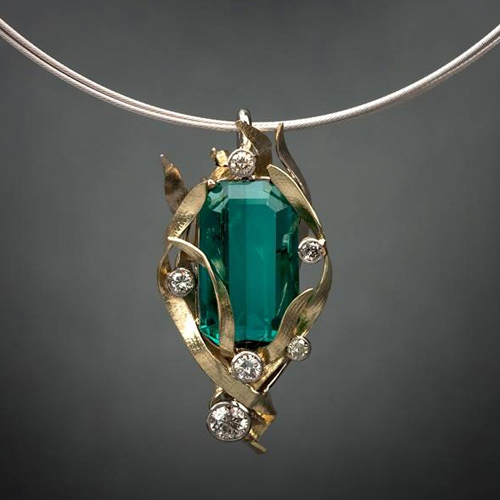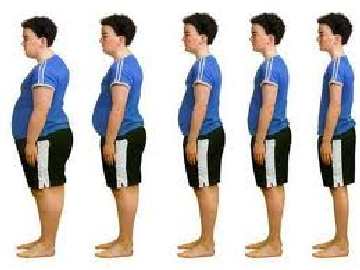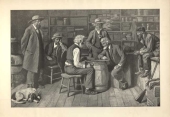The Checker Maven
The World's Most Widely Read Checkers and Draughts Publication
Bob Newell, Editor-in-Chief
Published every Saturday morning in Honolulu, Hawai`i
Noticing missing images? An explanation is here.
Pages: «Prev
|
1 |
2 |
3 |
...|
80 |
81 |
82 |...|
126 |
127 |
128 |
Next»
Lucky Day
Our automated system was mis-programmed and published two articles today, including next month's installment of Checker School. It's our readers' lucky day, so enjoy the extra article while your editoral team scrambles to write another for the month of May!
When Wyllie Wavered
The usual definitions of wavering are (1) to move unsteadily back and forth, and (2) to exhibit irresolution or indecision. But in seeking an image to illustrate the concept of "wavering" we came across some really unusual interpretations, such as the painting above. We'll guess that maybe the boat is "wavering" on the waves? It's a pun bad enough to be worthy of The Checker Maven editoral staff! We also ran into a rock album called "Wavering Radiant"; some jewelry pieces with "wavering" patterns; and a lot more bizarre stuff that seemed at best tangentially related to the basic definitions.
Willie Ryan implies, in the excerpt below from his famous book Trips Traps & Shots of the Checkerboard that the great Wyllie "wavered" in losing in a most uncharacteristic manner. Maybe that's Willie's own definition of the word, and would be yet another to add to a growing list. But whatever you might call it, the checker play is fascinating and instructive. Willie will explain.
"James Wyllie seldom lost a game by a pitch or an unexpected shot. Those who beat him had to do it the hard way, by protracted end-game play. The following example records one of those relatively rare occasions when the canny Scot got what is commonly known as the 'Bum's Rush,' at the hands of James Mugridge of Buffalo, New York:
| | 11-16 | 9-14 | 4- 8 |
| | 24-20 | 18-9 | 29-25 |
| | 16-19 | 5-14 | 11-15 |
| | 23-16 | 25-22 | 27-24---2 |
| | 12-19 | 8-11 | 8-11---3 |
| | 22-18 | 22-17---1 | 32-27---A, |
| | | forms the
|
| | diagram. |
WHITE
 BLACK
Black to Play and Win
BLACK
Black to Play and Win
B:W31,30,28,27,26,25,24,21,20,17:B19,15,14,11,10,7,6,3,2,1.
A---Loses, and marks the spot where more than a few great players have fallen. The correct draw play is: 17-13, 3-8, 32-27, 15-18, 24-15, 10-19, 27-24, 7-10 (11-15, 20-16, 14-17, 21-14, 7-10, also resolves a draw), 24-15, 10-19, 26-22, 19-23, 22-15, 11-18, 20-16, 8-12, 16-11, 12-16, 11-8, 16-20, 31-26, 23-27, 26-22, 18-23, 22-18, etc. Wm. F. Ryan."
1---27-23 might be slightly better here---Ed.
2---Definitely not as good as 27-23. The computer gives Black a small edge here---Ed.
3---It took deep computer analysis to show that 1-5 may instead be the best way to retain Black's slight lead---Ed.
The solution is quite long, but don't waver for a moment. Work it through and then wave(r) your mouse over Read More to see the rest of the play.
[Read More]
The First Stroke of Spring
Spring in North America, after a long winter of snow, cold, and darkness, is a welcome time. And although the photograph above is a little beyond the very first stroke of spring, it's an apt illustration of how beautiful the season can be.
Today, we present you, in checkeristic terms, with the first stroke (problem) of the spring season. We know that many of you would rather be outdoors at long last, and not seated indoors at the checkerboard, so we suggest that you have the best of both by taking your checkerboard out on the porch or patio and working on today's remarkable problem.
BLACK
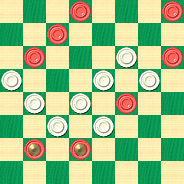 WHITE
White to Play and Win
WHITE
White to Play and Win
W:W23,22,18,17,16,15,13,11:BK26,K25,19,12,9,6,4,2.
Keen powers of visualization are needed to see how to do this one, but we assure you it's worth the effort; the solution is as spectacular as the new blooms of the season. Do give it a go, and then spring your mouse over to Read More to see the solution.
[Read More]
Winter's End
By the time this article appears, winter should be coming to an end in much of North America, and a welcome thing that will be for those who endured repeated blizzards and lasting cold. The coming of spring will bring a huge sigh of relief to winter-weary Americans and Canadians.
Here at our Honolulu editorial office, we too experienced winter cold spells with temperatures that dropped as low as 63 F, though we don't expect much in the way of sympathy from our readers.
But wherever you live, let's celebrate spring together (if you're in the southern hemisphere, let's welcome the advent of fall; we've heard that Australia was mighty hot during some of the austral summer), and let's do it with a challenging checker problem authored long ago by George King.
BLACK
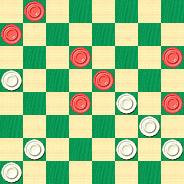 WHITE
White to Play and Draw
WHITE
White to Play and Draw
W:W29,28,27,25,24,19,13:B20,18,15,12,10,5,1.
Forces are even, but White has a really limited choice of moves and could be in serious difficulty. But, just as you would clear a path through the blizzard's snow, there is a way out of White's predicament here. Can you find it and secure the draw?
Shovel your way through the complications and find the path, then dig your mouse on Read More to see the solution.
[Read More]
See Right With Searight
This month's Checker School lesson considers a position published by the great late 19th century player and analyst, J. Searight. It's a problem with a twist, a surprising move that requires keen "checker vision" to find. Now, the glasses worn by the couple in the photo above are not likely to bestow "checker vision" upon them; the result might be more akin to a headache, so we recommend instead that you put on a set of imaginary lenses of the kind that can enable you to solve the problem position shown below.
J. SEARIGHT
WHITE
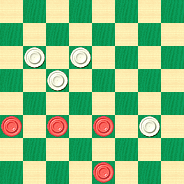 BLACK
Black to Play and Draw
BLACK
Black to Play and Draw
B:W24,23,19,9:B12,11,10,2.
This is something like last month's Checker School entry, but of course small differences matter, and Black can find a draw here if he views the position through the right lens.
Can you see right through this problem, or do you have trouble focusing? Never mind; after you've eyeballed it for a while, click on Read More for a clear view of the solution, two sample games, and descriptive notes.
[Read More]
Another Heffner Gem
The term "gem" is often used to describe a particularly elegant checker problem; we've discussed this at various times and at various length in previous editions of The Checker Maven. What qualifies as a "gem" is highly subjective, and seems to fall into the "I'll know it when I see it" category. Now, there is no doubt the elegant piece of jewelry shown above is a "gem" in more than one sense of the word. Whether or not today's excerpt from Willie Ryan's Tricks Traps & Shots of the Checkerboard falls into the "gem" category is something you'll have to decide for yourself, after Willie sets the stage for us.
"Back in 1925, when I was learning checkers the hard way, I played the following game in a 30-game match with Mike Lieber, of Detroit, then one of the country's leading players:
| 10-14 | 27-24 | 11-16 |
| 22-17 | 3- 7 | 24-20 |
| 6-10 | 24-19 | 17-21 |
| 17-13 | 11-16 | 20-11 |
| 1-6 | 20-11 | 7-i6 |
| 25-22 | 8-24 | 26-22 |
| 14-17 | 28-19 | 16-20---A,1 |
| 21-14 | 4-8 | 22-17 | |
| 9-25 | 22-18 | 20-24 |
| 29-22 | 14-17 | 18-14 |
| 10-14 | 32-27 | 2-7, |
| 24-20 | 8-11 | reaching the |
| 7-10 | 27-24 | diagrammed |
| | position." |
BLACK
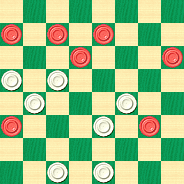 WHITE
White to Play and Win
WHITE
White to Play and Win
W:W31,30,23,19,17,14,13:B24,21,12,10,7,6,5.
A---The losing move. 10-14 will insure a draw with a little care."
1---It seems somewhat unintuitive that going in for a king would lose, yet it indeed does. We ran a computer analysis, and it was interesting to see the computer start out by evaluating this as a weak move, but, as it ran deeper and deeper searches, downgrading the move to a highly probable loss. We can easily understand how a human player, even of Mr. Ryan's strength, could make this move---Ed.
We find Willie's comment, by the way, about "learning checkers the hard way" to be very revealing: if Willie learned "the hard way" then we suspect that all the rest of us learn the same way. Alas, there is no royal road to checker success--- but where would the fun be if there was?
In any event, see if you can find that sparkling, precious winning way, and then click on Read More to see all the facets of the solution.
[Read More]
How to Win at Checkers
Today we're at long last presenting you with a newly-typeset electronic edition of one of the most complete books on the basics of the game ever published, Fred Reinfeld's How to Win at Checkers. We've previously written about Mr. Reinfeld and published a review of his book. Now, thanks to the generosity of Mr. Reinfeld's estate, who kindly authorized this edition, the book is available instantly, worldwide, and entirely free of charge. You can download it here.
Our further thanks and appreciation go out to anonymous checkerist "Mr. T." who scanned and edited the initial drafts of the new edition, reset the diagrams, and passed the results along to us.
To introduce you to the book, we've picked out a problem situation and present it below. (The book doesn't really have problems per se, just examples; but you can make your own problems by trying to solve the diagrams before looking at the text below them.) Here's a run-up to the diagram.
| BLACK | WHITE |
| 1. | 10-15 | 22-18 |
| 2. | 15x22 | 25x1 |
| 3. | 6-10 | 29-25 |
| 4. | 10-15---A | 25-22---B |
A---An inferior move played to set a trap (usually bad strategy). 11-15 was correct.
B---Loses; White should have played 18-14 to keep the advantage
WHITE
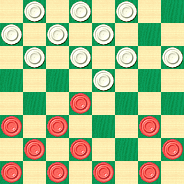 BLACK
Black to Play and Win
BLACK
Black to Play and Win
B:W32,31,30,28,27,26,24,23,22,21,18:B15,12,11,9,8,7,5,4,3,2,1.
We invite you to solve the problem, and then download the book to look up the solution (it is found under Diagram 33). We hope you enjoy and benefit from our new version of this classic work. 
Marvin Meets Mary
A huge crowd had gathered at Manhattan Square Garden to see the National Checker League match between the Detroit Doublejumpers and the New York Draughtsmen, two of the top teams in the league. The Doublejumpers would be lead as usual by their intrepid captain, Marvin J. Mavin.
 Marvin J. Mavin
Marvin J. Mavin
But what was not so usual is that the Draughtmen would be lead by an incredible young checker prodigy, who had recently burst upon the scene, turning pro at the age of 17 and moving at once to the top ranks: Marvin tonight would face checker sensation Mary Baloner.
 Mary Baloner
Mary Baloner
Marvin was more than a little put out. "A teenage girl for crying out loud!" he muttered, but not very loudly; he had been warned by his management that comments about age or gender were completely out of place, as checkers was a democratic sport open to all based solely on ability. Still, Marvin really, really wanted to win tonight.
"She's not even old enough to drink beer!" he said, but again, not loudly enough to be heard.
And now, there she was, standing opposite him as the last strains of the National Anthem echoed through the arena.
"Hey, Mavstah!" she exclaimed as they took their seats and waited for the arena announcer to introduce the teams and players. "Whaddya think about playin' a itsy-bitsy little girl, huh? Yeah, I know whatcha think. But youse gonna get your---" But before she could describe what was going to happen to Marvin, the announcer introduced them, and then the referee signaled for the games to start.
Mary gave Marvin a wink and a grin and made her first move, and the teams settled down to their play.
| Black | White |
| Mary | Marvin |
| 11-15 | 23-19 |
| 9-13 | 26-23 |
| 6-9 | 23-18 |
After Marvin made this move, Mary looked quite surprised. She looked up at him and said, "Oh, a wise guy, is ya, Mavhstah? A normal playah woulda played 22-18 but you ain't normal, is ya?" And then she laughed and turned her attention back to the checkerboard.
But Marvin thought he knew what he was doing. Despite Mary's superstar status, he knew that she wouldn't have experience in many of the offbeat lines of play, and he thought to get an advantage by taking the game into less familiar territory.
| 10-14 | 19-10 |
| 14-23 | 27-18 |
| 7-23 | 31-27 |
| 12-16 | 27-18 |
| 3-7 | 32-27 |
| 7-10 | 22-17 |
| 13-22 | 30-26 |
| 22-31 | 18-15 |
| 10-19 | 24-15 |
| 31-24 | 28-3 |
"Heh, heh, heh, fancy-schmancy," Mary said. "But I seen it all comin'."
| 9-14 | 15-11 |
| 5-9 | 25-22 |
| 9-13 | 3-8 |
| 14-18 | 22-15 |
| 2-7 | 11-2 |
| 4-18 | 2-7 |
Mary looked up at Marvin once again. "I thought youse was gonna play 29-25, Mahvstah. Whaddya doin, tryin ta confuse me or sumthin? Well it ain't gonna work against Mary Baloner!"
Marvin didn't reply. Was he holding his breath a little, waiting to see how Mary would respond to this move?
Marvin breathed a sigh of relief and spoke for the first time during the game. "Well, little Missy, you may think you are some sort of checker rock star, but this game is mine."
Now it was Mary's turn to be silent, a look of consternation gathering on her face as Marvin made his next move.
BLACK
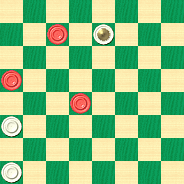 WHITE
White to Play and Win
WHITE
White to Play and Win
W:W29,21,K7:B18,13,6.
Can you beat Mary at her own game, so to speak? Do you know what move she should have played to hold the draw? See if you're as good as Marvin; find the winning move, and fix Mary's unfortunate error while you're at it. Then click on Read More to see the solution and the conclusion of our story.
[Read More]
Through Thick and Thin
It seems that both our editorial and art departments were working at reduced intellectual capacity when they came up with the theme for this week's column, Through Thick and Thin, relying on an obscure and not all that clever multilingual pun.
Though we'd rather not embarrass ourselves with the explanation, here goes: today's position is attributed to late 19th century checkerist George Dick. Now, in the German language, "dick" means "fat" or alternatively--- you guessed it---- "thick." It gets worse from here: the position below, having only a few pieces and those arrayed on just a few ranks of the checkerboard, is rather "thin" in looks. Thus we have "thick" and "thin" although frankly, we'd rather we didn't.
The job market in Hawaii isn't that great, so we won't fire all the staff and start over. Instead, we'll just "carry on" as usual, as there is some great checker content in today's problem, solution, sample game, and notes; there is even a short historical anecdote which contains a supplemental problem.
G. DICK
BLACK
 WHITE
White to Play and Win
WHITE
White to Play and Win
W:W30,24,23,22:B16,15,13,10.
The obvious question is this: what's here that can give White a win? White can win a man but Black will just get it back a couple of moves later. Yet the win is there, even if by just a "thin" margin. Can you find it, or is the problem a bit too dense (i.e., "thick") to solve?
You're surely a hardy checkerist, looking for the win through thick and thin, so go and find the answer, then click on Read More to settle the score.
My goodness, have we ever outdone ourselves this week.
[Read More]
Heffner's Hurricane
There's nothing like a hurricane to show the incredible power of nature, and if you've ever experienced one in person, you'll know exactly what we mean. The howling wind, the lashing rain, and if you're near the ocean, the roaring surf, combine in an incredible and fearsome cacaphony. In fact, this might be something better not experienced in person.
Hurricanes can take place on the checkerboard as well, and while they're destructive and fearsome in their own way, thankfully the only thing damaged is perhaps a player's ego, and even that not for long. Willie Ryan, in his fine book Tricks Traps & Shots of the Checkerboard, tells us today about a storm originated in the play of checkerist A. J. Heffner, and quite a tempest it is. Here's Willie to tells us more.
| 9-14 | 3-7 | 11-16 |
| 24-20 | 24-19 | 18-15 |
| 10-15 | 11-16 | 14-18 |
| 22-18 | 20-11 | 15-6 |
| 15-22 | 8-24 | 18-25 |
| 25-9 | 28-19 | 26-22 |
| 5-14 | 4-8 | 25-29 |
| 29-25 | 22-18 | 21-17 |
| 7-10 | 8-11 | 9-13 |
| 25-22 | 26-22 | 19-15---B |
| 6-9 | 1-5 | 2-9 |
| 27-24 | 31-26---A | 32-27---1 |
WHITE
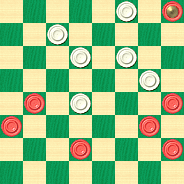 BLACK
Black to Play and Win
BLACK
Black to Play and Win
B:W30,27,23,22,17,15:BK29,16,13,12,9,7,5.
A---"If 32-28 is played, then a draw is established with: 11-15, 18-11, 7-16, 22-17, 9-13, 28-24, 13-22, 24-20, 14-18, 23-27, 2-11, 19-15, 11-18, 20-11, 18-23, 11-7, 12-16, 7-2, 16-20, 2-6, 23-27, 31-24, 20-27, 6-10, 5-9.
B---Appears to win, but loses. The correct play is: 6-1, 7-10, 32-28, 5-9, 1-6, 9-14, 6-15, 14-21, 22-18, 29-25, 18-14, 25-22, 14-10; at this point 13-17* is drawable, but 22-26 allows the hidden win by white with: 28-24*!, 16-20, 30-25*!, 21-30, 23-18, 20-27, 19-16, 12-19, 15-22. I missed this pulverizer against Tom Wiswell in the 1940 New York State Championship Tourney."
1---23-18 appears to be better here, but still loses. As the proverbial exercise for the reader, you might wish to work out this alternative line of play, perhaps with the help of your computer---Ed.
Don't be blown away by this one; find your way through the storm and reach the solution. When you're finished, click on Read More to clear the air.
[Read More]
Pages: «Prev
|
1 |
2 |
3 |
...|
80 |
81 |
82 |...|
126 |
127 |
128 |
Next»
The Checker Maven is produced at editorial offices in Honolulu, Hawai`i, as a completely non-commercial public service from which no profit is obtained or sought. Original material is Copyright © 2004-2025 Avi Gobbler Publishing. Other material is public domain, as attributed, or licensed under Creative Commons. Information presented on this site is offered as-is, at no cost, and bears no express or implied warranty as to accuracy or usability. You agree that you use such information entirely at your own risk. No liabilities of any kind under any legal theory whatsoever are accepted. The Checker Maven is dedicated to the memory of Mr. Bob Newell, Sr.

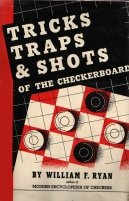

![]()







